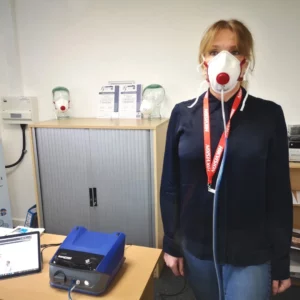Menu
free shipping on orders over £100
free shipping on orders over £100
WHAT IS A FACE FIT TEST?
Face fit testing, a legal requirement in the UK is and an essential process to ensure respiratory protective equipment (RPE) is correctly fitted to an individual to protect them from hazardous substances.
The Health and Safety Executive (HSE) outlines that a fit test must be carried out for all wearers of RPE every two years by law, more frequently if there are any significant facial changes (such as dental work / significant weight change). Re-testing is also required if there is a change of RPE device. The aim of the test is to ensure that the respiratory protection provided meets the specific requirements of the wearer and is detailed in the CoSHH regulations.
HOW DOES THE TEST WORK?
In partnership with our respiratory specialist, Intersafety offer the quantitative fit test which may, subject to terms and conditions be a free of charge service when arranged alongside a purchase of respirators. The test uses a PortaCount machine which measures the amount of leakage around the respirator’s face seal. The machine monitors and records the concentration of particles inside and outside the mask while the wearer completes a series of exercises. The machine then calculates the fit factor and gives a numerical value indicating the effectiveness of the product.
WHY IS FACE FIT TESTING IMPORTANT?
Due to incorrect or poor fitting, research suggests that a significant proportion of RPE in the industrial workplace does not provide acceptable levels of protection. This means hazardous particulates and substances could still harm workers despite wearing the correct RPE for the task.
YOUR MASK CANNOT PROTECT YOU IF IT DOES NOT FIT CORRECTLY.
WHO SHOULD BE TESTED?
All wearers of tight-fitting RPE should be tested. This is equipment that requires a face seal to work effectively. This can also be determined by the type of respiratory protection. Click on the links below to find out more:
FACIAL HAIR
Effective respiratory protection relies on a good seal between the mask and face. Facial hair (stubble and beards) makes it impossible to maintain this seal. As a result, face fit testing requires the wearer to be clean shaven. This prevents leakage of contaminated air into the mask and subsequently the lungs. Education on the importance of being clean shaven should form part of the Fit Test process.
If the wearer provides good reasoning for facial hair, such as religious background, powered air provides a suitable alternative without the need for a tight fit to the face. If the wearer is unable to shave or work elsewhere, the employer must offer a solution in place of standard respiratory protection.
CAN WE JUST DO THE TEST OURSELVES?

Fit testing should be carried out by a competent, qualified person with experience. Our service is delivered by a qualified Fit2Fit accredited assessor, providing complete peace of mind that RPE is correctly fitted. Whilst it is permitted to for companies to purchase their own face fit testing kits and carry out their own testing, the benefits and easier access to higher level PortaCount machine testing is making the old style qualitative testing less attractive.

Sign up to our mailing list and keep up to date with all the latest products, deals and discounts!


This company undertakes to supply only safety equipment and/or related services that fully comply with the standards and regulations and claims made relating to those products and/or related services. Where appropriate, this company will maintain up to date technical files and associated documentation to ensure that regulatory compliance information can be supplied upon request.
Where products are sourced from external organisations which hold technical files relating to the products being offered, this company will request confirmation that these files are current, complete, contain appropriate conformity assessment information and, where relevant, regulatory compliance certificates and will take all necessary steps to confirm the validity of the compliance documentation held by that external supplier in respect of the products being sourced.
Where services are provided related to safety equipment sourced from external organisations, this company will maintain approval from the manufacturer that the services provided are assessed and approved by the external organisation.